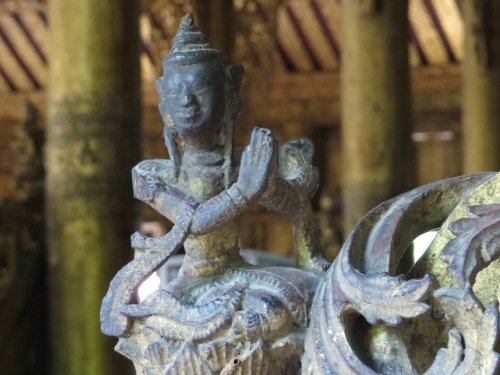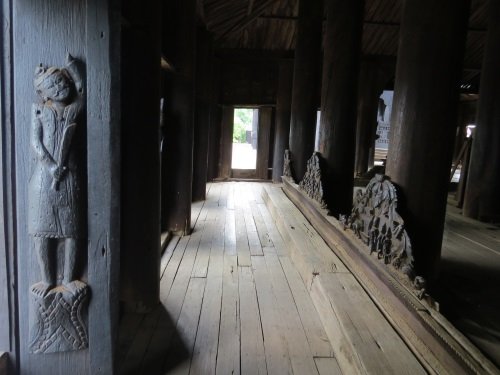The Konbaung Dynasty was the last Burmese monarchy before British colonial rule started in 1885. With their expansionist agenda they set the current borders for Myanmar. Since 1996 a group of 7
Wooden Monasteries from the Konbaung Period
has been on Myanmar’s Tentative List. They are located in Ohn Don, Sala, Pakhangyi, Pakhannge, Legaing, Sagu and Mandalay – scattered roughly in the area between Mandalay and Bagan. In contrast to the earlier brick architecture of the Pyu and Bagan civilizations, these monasteries owe more to pre-Buddhist Southeast Asian house-building practices and beliefs than to Indian prototypes.

|
|
Shwe-Kyaung in Mandalay
|
Shwe-Kyaung
in Mandalay was my first encounter with these teak wood monasteries. I had been cycling around town all morning without seeing many tourists, but this is a major sight well on the beaten track of every tour guide. There’s an entrance fee to this and all other landmarks of Mandalay (valid for 5 days), costing 10,000 kyat / 7 EUR.
The building originally belonged to the royal palace and was intended as sleeping quarters for the king. After he died, the building was donated to a Buddhist monastery in 1883. It became known as the Golden Monastery, because the wood was completely gilded. Inside it has still partially retained its golden glow. The main attractions however are its many finely carved figures, especially the
Jataka scenes
. This was the most outstanding single monument that I saw in Myanmar.

|
|
Ornate woodwork, gilded pillars
|
At the end of my trip I set my sights on the fairly obscure Pakhangyi and Pakhannge monasteries. The travel agency where I booked my car plus driver was confident about getting me there. And indeed the next day we drove straight to Pakhangyi, where a 5,000 kyat entrance fee was collected. This former monastery
clearly demonstrates the linear plan
typical of the Konbaung monasteries, with 4 buildings in a row (shrine - prayer hall - main teaching hall - ancillary building). It is raised on 254 pilings, with access to the main platform via massive staircases made of brick and stucco. It is more simple than the one in Mandalay, but I liked the human figures carved into the doors. The building has undergone major renovations in 1992,
"ordered by the military regime’s former spy chief Khin Nyunt
" – photos inside show the rickety state it was in before that.
My final goal was the elusive Pakhannge. The given GPS coordinates point to a spot right in the middle of a river. The travel agent told me I should cross the river and that the driver would wait. We drove for only 5 km from Pakhangyi on a narrow country road, slowed down by a
festive election parade for Aung San Suu Kyi’s NLD
in front of us. We ended up at the Chindwin river, where the ferryman came into action rightaway. The crossing was short and smooth, and on the other side I asked for ‘Pakhannge Kyaung’. I was enthousiastically guided to … the ‘modern’ monastery in town. This involved some serious mud hiking, as the pouring rain had turned the town’s sandy streets into a mess. They were so kind to lend me an umbrella though.
With no English speaking local around, I showed the curious onlookers some of my photos from earlier in the day of the wooden monastery of Pakhangyi - hoping this would trigger a recollection of something similar in their village. The photos were easily recognized as being of Pakhangyi, and they pointed to the road where I just came from. Yes I know where Pakhangyi is, because I was there an hour ago. But where did the monastery of Pakhannge go? So in the end I never found it - it was the largest of this group of wooden monasteries, standing on 332 piles. The building itself seems to have collapsed.

|
|
Beautiful door at Pakhangyi
|
I haven’t found any indication that Myanmar is actively pursuing this as a future WHS. A complete nomination dossier would need substantial documentation, something that now seems to be lacking at least in English. The cost of such an undertaking may be too much for the Myanmar Department of Archeology, National Museum and Library. Maybe they can get help from a donor such as Japan with its strong tradition in wooden architecture.



